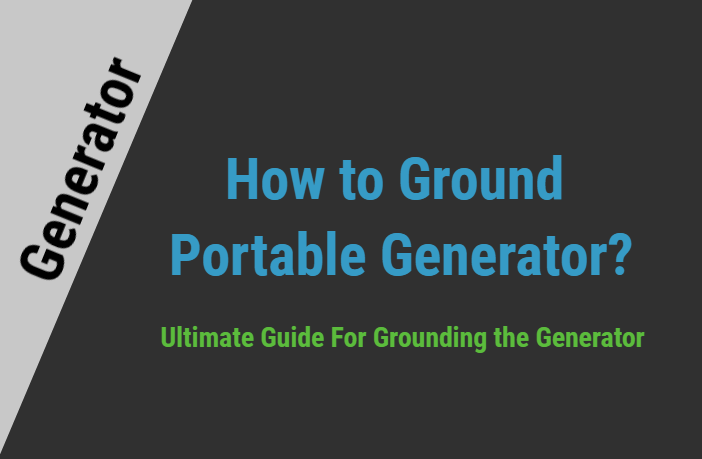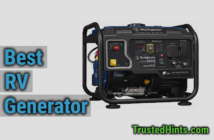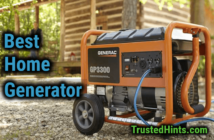I bet you have heard about the grounding, and it is important to keep you and your appliances safe. You may already be using grounding techniques in your house for protection against lightning, electrocution, and ground-fault current.
To be on the safe side, you also need to ground various electronic devices such as a portable generator. The portable generator is used for a variety of applications, including powering your tools on Jobsite or running onboard devices on an RV or as a home backup.
However, not all generators need to be grounded. In certain scenarios, you may need to ground your portable generator. So in this article, I will explain how to check if you need to ground your portable generator, why you need to do so, and I will explain some terminologies such as neutral bonding, separately derived system, and ground-fault current path.
What is grounding?
Grounding refers to connecting to an electric circuit or device to reference ground. The reference ground has zero potential difference. Now, if the current from the electric circuit leaks, then it needs some path to flow to the earth’s surface; thus, the electric machine will be safe. This excess current will flow through this reference ground to earth and this way, you will not get an electric shock by touching such a machine.
In the case of a generator, all the conducting parts of the generator, including the fuel tank, engine, and receptacles, are connected to the outer frame of the generator. So you do not need to ground your generator, and this arrangement is known as a neutral bonded frame. But keep in mind that not all the generators come with this arrangement.
The purpose of neutral bonding is to ensure the generator level grounding meaning that if there is a leaking current from the generator body, then it will be grounded immediately. And also, it makes sure that the GFCI (Ground Fault Circuit Interrupter) breakers are working properly.
Moreover, the floating neutral is also the same as the neutral bonding that I explained above. You may have heard this terminology when referring to RV. If you are using a generator for your RV, then listen carefully.
In Floating neutral, the neutral or ground is connected to the body of RV and not the earth. So it means that the floating neutral is not connected to the earth directly, which eliminates the need for using the grounding rod.
Please note that, when you are using the generator on a boat, it does not count as floating neutral because the water floats on the ground.
Read Also,
Do I need to ground my portable generator?
First of all, let us understand the difference between grounding, neutral bonding, and floating neutral. In grounding, the additional connection is made between the generator body and earth with the help of a metal rod which is driven deep into the ground. Neutral bonding and floating neutral is the same but differ when referred to different machines.
In neutral bonding or floating neutral, the conducting components of any machine or generator are connected to the outer body and not the ground. So it can safely ground leakage current to earth.
If you are using extension cords to run appliances through the generator, then you do not need to ground your generator. And this same applies when you are using the generator for your RV, camping or any other recreational use as long as you only use the extension cords. You also need to make sure that the ground of the RV is connected to the generator and not the shore power.
Whenever you are using your generator on Jobsite to run power tools, then according to OSHA regulations, you need GFCI equipped outlets that most of the industrial generators already come with.
Moreover, if you are using the portable generator to run appliances in your home through a transfer switch, then the grounding becomes a little more complicated, and that’s where a separately derived system comes in.
A transfer switch is one of the most essential accessories for a portable generator. The transfer switch allows you to safely switch between the grid’s power and generator’s power without any short-circuits. However, not all the transfer switch uses the same grounding method.
Some transfer switches have the common neutral, which is connected to both the generator and primary circuit of the house. So during a power outage, when the transfer switch changes the power supply, the neutral does not change, but instead, only the hot circuit is changed.
As you know, the neutral connection of the generator is connected to the home’s permanent earth ground, and so is the house itself, which eliminates the need for using additional electrodes for grounding.
The separately derived system is different than the method I explained above. In this system, when the power is switched from grid to generator, the neutral also changes. This means that the main neutral connection is no longer connected to your house, and in this case, you have to install the additional grounding for your generator.
By reading the above situations, you can decide whether you need to ground your generator or not. But to be on the safe side, we advise you to install the grounding anyhow, here’s one good example of it.
Sometimes there may be some leakage current in your generator which can electrocute you; thus, it endangers your life. By grounding your generator, you can eliminate this problem altogether, so that is why grounding your portable generator is very important.
A step by step guide to a ground generator
Above, you have read why grounding any portable generator is necessary and its benefits. Now, let’s talk about how you can ground your generator in your home without needing any electrician. Follow this step by step guide to meet the electric codes.
What tools do you need to ground a portable generator?
1. 8-inch grounding rod
I have seen so much wrong information regarding the length of the grounding rod. Many people on the internet are suggesting that you should use a 4-feet grounding rod, which is completely wrong. You need to at least an 8-feet long and ½-inch diameter copper rod. Copper is usually cheaper and great conducting material for grounding purposes. Due to its long length, you can drive it deeper for a better conducting path. Driving it 4-feet deep into the surface will do the trick.
2. Copper wire
For the connection between the generator and earth, you need a copper wire. There is no required length for this as long as the wire can successfully reach the grounding rod. The national electric code recommends that you should use at least 6 or 8 gauge wire for grounding purposes, but for small generators, it can be too much. Also, please make sure that the copper wire is not too thick or too thin. If you are not sure how thick copper wire should be, then read the generator’s manual, and you will be good to go.
3. Lugs and connectors
Most people wrap the wire around the grounding rod and neutral bonding nut for grounding, which is not safe in my opinion. In some instances, the wire around the rod may get loose, and thus, the grounding circuit is broken, which is very problematic. To avoid this problem, you should use the lugs or solder the wire to the rod.
4. Salt, charcoal, and water
Sometimes the land near your home isn’t conducive (or it is completely dry) enough to carry the leakage current to the deeper ground. To make it more conductive, you need to dig a deep hole in the land and put the layer of charcoal and salt on top of each other and then pour some water in it and then drive the rod in it.
5. Hammer/sledgehammer
In order to drive the copper rod into the ground, you will need a hammer. You may already have the required tools at your home to dig a good portion of land. Also, be very careful when driving the copper rod into the hole to make sure it doesn’t get damaged.
How do I ground my portable generator?
First of all, you need to dig a deep hole in the land near your home. In that hole, you need to make many layers of salt and charcoal on top of each other and pour some water on it. After that, drive the copper rod at least 4-feet deeper into that hole. You can skip the procedure of laying charcoal and salt if your land is not that dry or rocky.
Now attach one end of the copper wire to the neutral of the generator and attach the second end to the copper wire. You can solder the wire after wrapping it around the rod or you can choose the bolt and lug connecting method. If you choose the bolt and lug, then make sure to flatten the rod with the help of a bench grinder first.
You need to make sure you are connecting the right neutral of your generator to copper wire. The generator’s manual will help you with this. After double-checking, all the connections, tighten the bolts of the connection on the generator as well on the grounding rod, and you are done.




